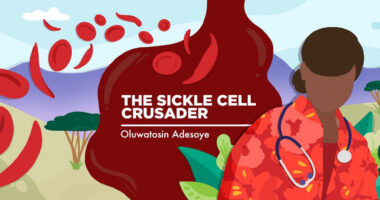The difference a day unit makes: Quick care stops a sickle cell crisis
Specialist treatment prevented my pain crisis from spiraling out of control

When you live with sickle cell disease, the chance of a hospital admission is always one crisis away. Pain can escalate quickly, infections can creep up without warning, and what starts as a niggle can spiral into something that takes you out of your daily life for weeks. One day you’re fine, the next you’re doubled over with severe pain that feels unbearable.
In those moments, access to quick, specialist treatment is the difference between managing the event at home and ending up in the hospital for days — sometimes weeks. That’s where day units and community care come in.
A day unit is a specialist service that people with sickle cell can attend during the day to receive urgent treatment — things like IV pain relief, fluids, oxygen, or antibiotics. The staff know sickle cell well, so we don’t have to waste precious time explaining or fighting to be believed. We get the treatment we need and in a timely manner. Most importantly, we can go home the same day.
Community care is equally important. It means having access to treatment closer to home, sometimes even at home, which can stop a crisis from spiraling. If flare-ups and infections are treated quickly, it can prevent a hospital admission altogether. That reduces pressure on hospitals and lets patients recover in their own environment, their lives less disrupted. I’ve never experienced community care for sickle cell, but I have for my oxygen treatment.
Both day units and community care make a world of difference.
For want of a day unit
I recently developed an infection that triggered a sickle cell crisis. If there’d been no day unit, my only option would have been emergency care and I likely would have been admitted into the hospital. Once that happens, things take longer. Pain lasts longer. Recovery takes longer. And the impact on everyday life is so much worse.
Having that happen would have been especially worrying for me right now. I’ve just started a job I really enjoy and a long hospital admission would almost certainly have meant significant time off, possibly weeks. That’s the kind of absence that could cause me problems.
I’ve also got several functions with family and friends coming up this month, which I’ve been looking forward to for ages. Missing milestones is one of the hardest parts of living with sickle cell. Without the day unit, I’d have missed a lot.
This is the reality so many sickle cell patients face when the right services aren’t in place. It’s not just about pain and hospital stays; it’s about the detrimental impact on jobs, careers, and cherished moments with loved ones. The knock-on effects ripple through every facet of life.
Because I had access to a day unit, things played out very differently. I was treated over two days and, from the moment I walked in, the staff took my pain seriously. There was no fight to be believed, and no exhausting wait. I was given the right pain relief and care straight away in accordance with my care plan. Gradually, the pain subsided and I was able to go home both evenings, rather than be admitted. A chance to avoid an admission, recover quicker, and get back to normal life is priceless. I only had to take three days off work. Three days, not three weeks, and I hope I won’t have to miss any of the events I’ve been looking forward to.
The day unit turned what could have been a major setback into a manageable bump in the road. It helped preserve my health, my job, and my social life. It gives people like me a chance at a fuller life by reducing the time stolen by sickle cell disease. Lord knows, I already miss enough because of it.
Note: Sickle Cell Disease News is strictly a news and information website about the disease. It does not provide medical advice, diagnosis, or treatment. This content is not intended to be a substitute for professional medical advice, diagnosis, or treatment. Always seek the advice of your physician or other qualified health provider with any questions you may have regarding a medical condition. Never disregard professional medical advice or delay in seeking it because of something you have read on this website. The opinions expressed in this column are not those of Sickle Cell Disease News or its parent company, Bionews, and are intended to spark discussion about issues pertaining to sickle cell disease.








Leave a comment
Fill in the required fields to post. Your email address will not be published.